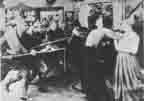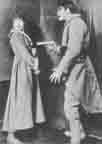 |
 |
The outbreak of the First World War in 1914 found the movies too much engrossed with their own burgeoning growth to recognize the opportunities it provided. But the arrival from Europe of films partisan to both sides of the conflict and the growing division of the American public into "preparedness" and "pacifist" camps soon opened new boxoffice possibilities. Then The Birth of a Nation demonstrated conclusively that the screen was an unrivaled medium for propaganda and polemics. In the autumn of 1915, J. Stuart Blackton, partly at the instigation of Theodore Roosevelt, filmed Hudson Maxim's book Defenseless America as The Battle Cry of Peace. It attacked the Germans as "Huns" and contended that only by arming to the teeth could America keep out of war. The film created an unprecedented controversy. No less a personage than Henry Ford took full-page newspaper advertisements to denounce the author of both book and film as a "merchant of death" whose real purpose was to increase the sale of his munitions stocks.
More extraordinary still was The Fall of a Nation, product of the unlikely collaboration of Victor Herbert and the Rev. Thomas A. Dixon. In it a leading pacifist, a thinly disguised William Jennings Bryan, persuades the country that all that is needed to defeat aggression is sweet reasonableness, with national catastrophe as the result. But such films, while appealing to the preparedness-minded, alienated pacifists and isolationists, and Thomas Ince's Civilization shrewdly straddled the situation by being at once antiwar and anti-German. It featured a secret army of women pledged to stop the slaughter by refusing to bear any more cannon fodder. A similar theme animated Nazimova's War Brides, which was abruptly withdrawn in April 1917 because "the philosophy of this picture is so easily misunderstood by unthinking people that it has been found necessary to withdraw it from circulation for the duration of the war."
The fact that any motion picture had to be withdrawn for reasons of national morale was startling in 1917. Movie-makers suddenly found themselves the wielders of a formidable weapon. The Democratic National Committee had credited Civilization with helping elect Wilson in 1916 on the "he kept us out of war" platform. Now the movies were to be used for exactly the opposite purpose. The Committee on Public Information created a Division of Films "to sell the war to America."
 |
 |
Pleasurably aghast at French and British reports of German brutality and vandalism, American filmmakers concocted a cinematic frightfulness which even outdistanced its supposed model. The composite portrait of the hideous Hun, usually embodied by Erich von Stroheim, George Siegman, or Walter Long, showed him a fiendish torturer and sadist who thought no more of raping a ten-year-old girl than of sweeping a priceless piece of Sèvres from the table in order to make room for his feet, in the aristocratic French château which he invariably commandeered as his headquarters. He was not quite shown bayonetting babies but the screen did not stop short of much else. Over and over---almost routinely---audiences were treated to the spectacle of the honor of innocent American womanhood saved from despoil at the very last split second. Seldom, if ever, had so much venom been channeled through the medium of the screen. But the overdose brought its reaction. After November 11, 1918, films about the war, especially those aimed at stirring up hate, became totally unsalable.

| Death before dishonor. Robert Harron prepares to shoot his sweetheart, Lillian Gish, rather than allow her to fall into the hands of the Huns, in D. W. Griffith's Hearts of the World, 1918. |